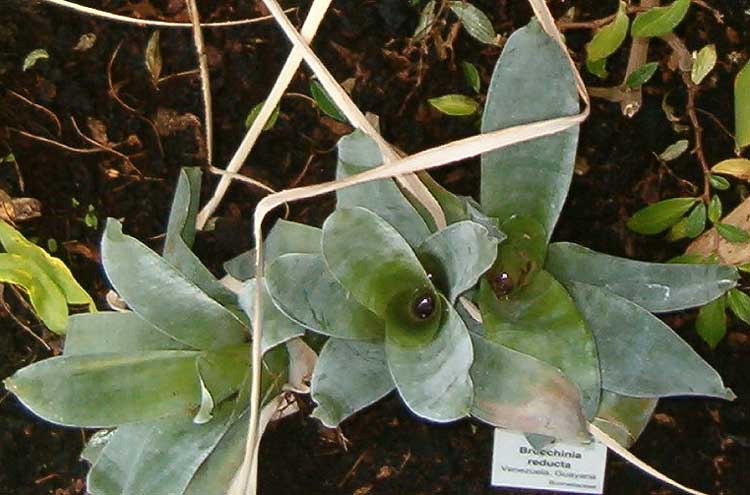
Brocchinia reducta (*)
Classification System: APG IV
Superregnum: Eukaryota
Regnum: Plantae
Cladus: Angiosperms
Cladus: Monocots
Cladus: Commelinids
Ordo: Poales
Familia: Bromeliaceae
Subfamilia: Brocchinioideae
Genus: Brocchinia
Species: Brocchinia reducta
Name
Brocchinia reducta Baker 1882
References
Baker, J.G., 1882. J. Bot. 20: 331
Gonzalez, J.M., K. Jaffe & F. Michelangeli 1991. Competition for Prey Between the Carnivorous Bromeliaceae Brocchinia reducta and Sarraceniaceae Heliamphora nutans. Biotropica 23(4B): 602–604.
Givnish, T.J., Burkhardt, E.L., Happel, R.E. & Weintraub, J.D. (1984). Carnivory in the bromeliad Brocchinia reducta, with a cost/benefit model for the general restriction of carnivorous plants to sunny, moist, nutrient-poor habitats. American Naturalist 124: 479–497.
Plachno, B. J.; Jankun, A.: Phosphatase Activity in Glandular Structures of Carnivorous Plant Traps., International Botanical Congress 2005 Vienna, P1716, The Jagiellonian Univ., Inst. of Botany, Dept. of Plant Cytology and Embryology, Kraków, Poland.
https://web.archive.org/web/20080423075426/http://www.carnivorousplants.org/cpdb/SearchCPdb.php
Links
Govaerts, R. et al. 2019. Brocchinia reducta in World Checklist of Selected Plant Families. The Board of Trustees of the Royal Botanic Gardens, Kew. Published on the internet. Accessed: 2019 Jun 15. Reference page.
International Plant Names Index. 2019. Brocchinia reducta. Published online. Accessed: Jun 15 2019.
The Plant List 2013. Brocchinia reducta in The Plant List Version 1.1. Published on the internet. Accessed: 2019 Jun 15.
Tropicos.org 2019. Brocchinia reducta. Missouri Botanical Garden. Published on the internet. Accessed: 2019 Jun 15.
Vernacular names
Brocchinia reducta /brɒˈkɪniə riːˈdʌktə/ is one of a few carnivorous bromeliads. It is native to southern Venezuela, Brazil, Colombia, and Guyana, and is found in nutrient-poor soil.[1][2][3][4] B. reducta adapts to different environments, when growing on rocks it uses its roots as anchors.[5]
Structure
Brocchinia reducta, like many other bromeliads, forms a water-storing cup with its tightly overlapping leaves. The leaves surrounding the cup of B. reducta are coated with loose, waxy scales. These scales are highly reflective of ultraviolet light. Since many insects are attracted to ultraviolet (it is also reflected by many flowers), this is an efficient lure. The water in the cup also emits a sweet odor, which may serve to attract ants and other insects.[6] B. reducta absorbs its nutrients from the outer cell wall, which is covered in trichomes that can transport molecules as small as 6.6 nm.[7]
The loose scales provide a poor foothold for landing insects, causing them to slip into the water-filled cup and eventually drown.[8]
References
Kew World Checklist of Selected Plant Families
Hokche, O., Berry, P.E. & Huber, O. (eds.) (2008). Nuevo Catálogo de la Flora Vascular de Venezuela: 1-859. Fundación Instituto Botánico de Venezuela.
Funk, V. A., P. E. Berry, S. Alexander, T. H. Hollowell & C. L. Kelloff. 2007. Checklist of the Plants of the Guiana Shield (Venezuela: Amazonas, Bolivar, Delta Amacuro; Guyana, Surinam, French Guiana). Contr. U.S. Natl. Herb. 55: 1–584
Smith, L.B. & R. J. Downs. 1974. Pitcairnioideae (Bromeliaceae), Part I. Flora Neotropica, Monograph 14(1): 1–660
Brown and Martin (1984). "Stigma structure and variation in Bromeliaceae—neglected taxonomic characters". {{cite web}}: Missing or empty |url= (help)
Gonzalez, J.M.; Jaffe, K.; Michelangeli, F. (1991). "Competition for Prey Between the Carnivorous Bromeliaceae Brocchinia reducta and Sarraceniaceae Heliamphora nutans". Biotropica. 23 (4B): 602–604. doi:10.2307/2388398. JSTOR 2388398.
thomson. "canadian journal of botany".
Givnish, T.J.; Burkhardt, E.L.; Happel, R.E.; Weintraub, J.D. (1984). "Carnivory in the bromeliad Brocchinia reducta, with a cost/benefit model for the general restriction of carnivorous plants to sunny, moist, nutrient-poor habitats". American Naturalist. 124 (4): 479–497. doi:10.1086/284289.
Further reading
Adlassnig, W; Peroutka, M; Lendl, T (February 2011). "Traps of carnivorous pitcher plants as a habitat: composition of the fluid, biodiversity and mutualistic activities". Annals of Botany. 107 (2): 181–94. doi:10.1093/aob/mcq238. PMC 3025736. PMID 21159782.
Retrieved from "http://en.wikipedia.org/"
All text is available under the terms of the GNU Free Documentation License

